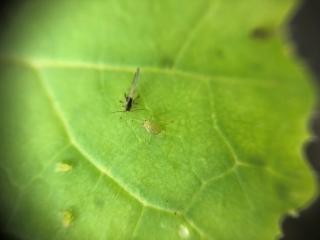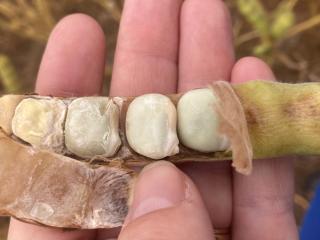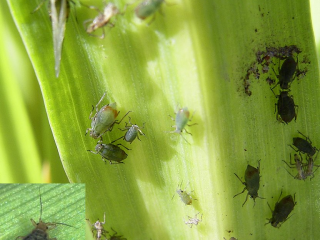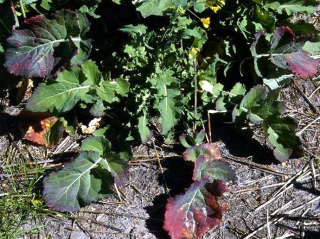Early season aphid and virus risk in cereals and canola
- Toodyay
- Nunile
- Muresk
- Kendenup
- Woogenellup
- Takalarup

This season, as part of a Department of Primary Industries and Regional Development (DPIRD) Boosting Grains surveillance project, DPIRD staff are monitoring green peach aphid (GPA) activity at certain sites in the Kwinana West, Albany and Esperance region. Yellow sticky traps have been put on fencelines to catch migrating aphids, and DPIRD staff are also conducting crop inspections and virus testing of captured aphids and inspected crops.
To date, various species of flying aphids have been caught at Toodyay, Nunile and Muresk in the Kwinana West zone, as well as at Kendenup and Woogenellup in the Albany zone. However, GPA have not been captured thus far. Oat aphid has been found colonizing grass weeds at Takalarup, so cereal crops in this area should be monitored for this species. No trapping data has been received from the Esperance zone yet.
Aphid and virus surveillance updates will be regularly shared via the PestFacts WA newsletter until crops have begun to flower and the risk of these aphid-transmitted viruses has reduced.
Impact of minimal summer rainfall on aphid populations
Aphids need non-crop hosts to survive over our long hot summer. If we don’t get a lot of summer rainfall, like this season, then aphids are often restricted to isolated damp areas like roadside ditches and home gardens.
In years where we receive substantial summer rainfall and a green bridge develops, aphids can build up their numbers to a point where, given the right cues, large numbers of them migrate into young crops during autumn and early winter. However, aphids are also greatly impacted by temperature and temperatures above 30 degrees greatly limit aphid populations and their ability to fly.
Despite the current gaps in our understanding of aphid migration dynamics, we can still make reasonably informed risk assessments by taking into account key factors such as the presence of a green bridge and temperature, along with on-the-ground data gathered from aphid monitoring programs.
Early season virus risk
Most broadacre grains viruses that infect our grains crops, particularly Barley yellow dwarf virus (BYDV) in cereals and Turnip yellows virus (TuYV) in canola, only cause significant losses when infection occurs before crop flowering. Furthermore, the risk of feeding damage by the aphid species responsible for spreading these viruses, oat or corn aphids (BYDV) and green peach aphid (TuYV), is greatest when they colonize the crop before stem elongation.
Due to the nature of our WA climate, early season spread of these viruses is relatively sporadic, and occurs under conditions that favor aphid migration from the green bridge into young vulnerable crops during autumn and early winter.
TuYV infection causes reddening, purpling or yellowing of the lower leaves of canola plants. Plants infected early (well before flowering) are often pale and stunted and these plants produce few flowers or seeds.
Symptoms of BYDV can be confused with those caused by nutrient deficiencies, waterlogging or other plant stresses that cause yellowing, reddening and striping of leaves. Leaf symptoms differ between wheat, oats and barley.
Sowing time may determine risk
Rainfall received in late March and April in many areas of the grainbelt has generated a green ramp, or green bridge, of crop volunteers (canola/ cereals), wild radish and grass weeds this season, especially on roadsides and in unsown and/or unsprayed paddock and pastures.
As many canola crops were sown not long after the first rain event of the season, they have co-developed with the green ramp. These earlier sown crops are progressing towards their mid-vegetative growth stages and are likely to be at a safer growth stage if, and when, aphids begin moving into crops and posing a risk for virus infection or early-season feeding damage.
However, crops sown more recently have been a bit slower to emerge, establish or develop in many areas due to a relatively dry past month. These later sown crops will be at greater risk from pests and pathogens building up in a more developed green ramp.
Aphids that can cause problems during the early part of the season, such as the GPA and cereal aphids are likely to be building up from a late start to their season. However, if WA growers continue to get relatively warm and dry conditions in the next six to eight weeks these aphids might begin to migrate into the later sown, and still immature, cereal and canola crops and pose a risk of virus spread and aphid feeding damage.
For more information on diagnosing and managing aphids refer to DPIRD’s Aphid management in canola crops and Diagnosing cereal aphids pages.
Management
There are a variety of management strategies that growers can employ. These range from selecting resistant varieties, delaying sowing to avoid peak autumn flights, sowing into stubble and applying foliar sprays to reduce aphid numbers.
Effective chemicals currently available in Australia for control of GPA are alarmingly limited as GPA has evolved resistance to many insecticide chemicals. For more information see GRDC’s Aphid and insecticide resistance management in grain crops.
For registered insecticide recommendations, refer to DPIRD’s 2023 autumn winter insecticide guide.
For more virus management information refer to DPIRD’s Managing barley yellow dwarf virus and cereal yellow dwarf virus in cereals and Turnip yellows virus in canola: diagnosis and management pages.
Further information
If you see aphids are colonising green bridge hosts, or you have symptomatic looking plants that you are concerned about, they can be tested for the presence of the viruses TuYV and BYDV through the Department’s Diagnostic Laboratory Services – Pathology Services.
For further information contact Research scientist Benjamin Congdon, South Perth on +61 (0)8 9368 3499.
Article authors: Benjamin Congdon (DPIRD South Perth) and Cindy Webster (DPIRD Narrogin).
Black and white tiger moth caterpillars
- Mullewa

Nic McKenna (Planfarm) recently found Black and white tiger moth caterpillars (Ardices glatignyi) feeding on canola plants near Mullewa.
This moth is not usually a crop pest but they do feed on a variety of herbaceous plants, so it is likely that the caterpillars initially hatched on weeds, which were subsequently sprayed out, prompting them to move onto the canola plants.
Black and white tiger moth caterpillars are initially white with a black head but later instars form a red-brown head capsule and have black or dark brown hairs covering the thorax and abdomen. Their prolegs are scarlet.
If control is required, these caterpillars are easily controlled with rates of synthetic pyrethroids registered for native budworm.
How to identify unknown caterpillars
Growers and consultants can use the PestFacts WA Reporter app to take clear, close up images of unknown insects found in crops and pastures, and plant symptoms, if applicable, and request a diagnosis.
For more information refer to the Butterfly house Black and White Tiger Moth page.
For more information contact research scientist Svetlana Micic, Albany on +61 (0)8 9892 8591.
Article author: Cindy Webster (DPIRD Narrogin).
Lupinosis risk this season
- Ranging from Geraldton to Albany and east into central grainbelt.

This season DPIRD has been notified of several cases of lupinosis in sheep following grazing of Phomopsis infected lupin stubbles, fallen harvested seed and pod trash in paddocks. The severity of cases has varied, and locations have been widespread and ranged from Geraldton to Albany, and east into the central grainbelt.
Conducive conditions for Phomopsis were experienced during pod filling and maturation in the wet spring last year.
A spike in cases were investigated by DPIRD Field Veterinary Officers and private vets in Geraldton, Northam, Kondinin, and Albany following the March 2023 rain events, which also increased fungal development.
What is Phomopsis?
Phomopsis stem and pod blight is caused by the fungus Diaporthe toxica.

Pod infection can appear as a dark lesion on the surface of the pod, affecting part or all of the pod. Pod lesions can lead to fungal growth inside the pod and seed infection, causing shrivelled or discoloured light to golden brown seeds. Cotyledons inside infected seeds can remain green rather than yellow.
Pod and seed infection are more likely when there is heavy rain during the period of seed and pod maturation. These circumstances were common last season.
Diaporthe toxica lesions are not usually visible on stems or branches of green plants, the fungus will infect green plants but remains latent as microscopic structures until senescence of the plant tissue. Rain and moisture on senescing or dry lupin stems allows the fungus to grow saprophytically producing characteristic black fruiting bodies on affected stubble.
Adverse reactions caused by Phomopsis
Phomopsis stem and pod blight occasionally causes yield losses, however the major impact of infection is the production of a toxin by the fungus as it grows in mature lupin stems or in seed.
The toxin can cause sickness or death (lupinosis) in livestock if they graze on infected stubble or if feeding of infected seed is poorly managed. Infected seeds are usually discoloured, ranging from golden to dark purple-brown colour.
One of the risk factors for sheep poisoning from lupinosis is when sheep are grazed too long in stubble paddocks. Sheep should be removed from the paddock when seed levels on the ground drop below 50 kg/hectare (about 40 seeds per square metre).
As the liver is damaged by the Phomopsis toxin, affected animals may present with several clinical symptoms, including jaundice (yellowing) of mucous membranes, and neurological symptoms such as blindness, loss of normal behaviour, head pressing, or blundering into dams or fences.
It is recommended that livestock producers report any abnormal behaviour or sickness to a DPIRD field veterinary officer, or your private veterinarian.
Further information
Guidelines for grazing stubbles or feeding of affected seed are available at the department’s Lupinosis in sheep page.
Further description of Phomopsis symptoms and management are available at the department’s Lupin foliar diseases: diagnosis and management and Diagnosing phomopsis stem and pod blight in narrow-leafed lupins pages.
For more information on lupin diseases contact Plant Pathologists Geoff Thomas, South Perth on +61 (0)8 9368 3262 or Ciara Beard, Geraldton on +61 (0)8 9956 8504.
For more lupinosis or livestock related information contact your local DPIRD field veterinary officer.
Article authors: Ciara Beard (DPIRD Geraldton) and Geoff Thomas (DPIRD South Perth).
Article input: Anna Erickson (DPIRD Narrogin) and Rod Thompson (DPIRD Northam).





